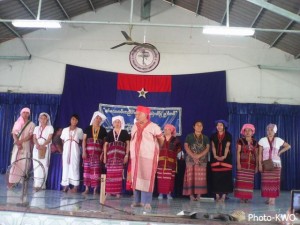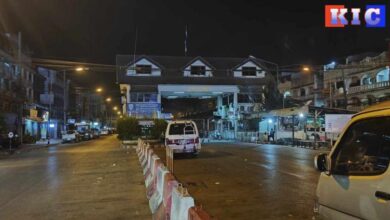KWO Marks 29th Years Of Standing Up For Women’s Rights

The Karen Women Organization held ceremonies on April 5 marking its 29th anniversary in locations in Karen State and along the Thai Burma border.
The KWO used its anniversary to draw attention to the status of women’s legal protection, the need to respect women and the need to promote women’s role in the peace process. The KWO released a report covering abuses against women.
The KWO’s 29th anniversary was celebrated in Karen State districts under the control of the Karen National Union and in refugee camps along Thai-Burma border – Mae La, Mae La Oon, Mae Ra Moe, Nu Po and Umpiem Mai.
Nan Dah Eh Kler, chairperson of the KWO, told Karen News that the occasion was also to celebrate Karen traditional clothing and fabrics.
“The KWO Day ceremony was organized in every refugee camp and district where its members are present. Karen people were directed to reveal and wear the traditional cloths worn historically by Karen people in each ceremony,” Nan Dah Eh Kler explained.
The Karen Women Organization was established in 1985 at the KNU’s former headquarters in Hpa-an District. The KWO promotes capacity building for women and campaigns for the eradication of abuses against women and children. In recent year the organization has released a number of reports that documented the systematic sexual abuse by the Burma Army ethnic women.
More than 150 people, including KWO officials and members of Karen community-based organizations attended the ceremony.
During the KWO anniversary ceremony a cultural competition was held that celebrated the diversity of traditional Karen clothing. Competitors were eligible to compete in 12 different categories and had to explain why they chose the traditional patterns they wore.
Nan Dah Eh Kler, the KWO chairperson, told Karen News that the day’s cultural competition was intended to highlight traditional Karen clothes that differ from patterns more commonly seen.
“We organized the competition show in this ceremony in order to retain the handmade Karen traditional clothes that were produced in the past and to show that Karen traditional clothes have their individual definitions,” Nan Dah Eh Kler said.
In addition, people who entered the competition could do so individually or in pairs. Cash prizes were awarded to the first, second and third place winners. Saw Kwe K’lu Htoo, a second-prize winner who took part as a pair explained what his entry involved.
“For both of us, joining the competition was to demonstrate the definitions of turban headband, men’s long shirt (pronounced “chay-pha-kwa,” in Karen) and the women’s white long shirt (pronounced “chay-mo-wah,” in Karen. The men’s long shirt, ‘chay-pha-kwa,’ varies in seize and can be worn from youth through to old age. The women’s long white shirt ‘chay-mo-wah,’ means white and pure and is worn only by women. It can only be worn by women from childhood until they lose their virginity.”




